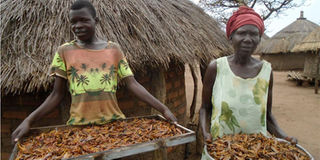Kitgum residents turn dreaded desert locusts into food

Kutansia Anena, 60, and her son display locusts they boiled for eating at their home in Gogo village, Lukwar parish in Kitgum District on February 19, 2020
What you need to know:
- Gen Chemo said his team responded late because they received information from the district late.
While government it struggling to find an effective way of dealing with the dreaded desert locust invasion, they have turned a blessing to residents of Kitgum District.
The residents are catching the locusts for food. The latest swarm of desert locusts invaded Gogo and Abudere villages in Lukwar Parish in Labongo Akwang Sub County on Tuesday evening. They settled overnight on tree branches and grasses covering a radius of more than three kilometres.
Several residents spent the better part of Tuesday evening and Wednesday morning picking the locusts for food. Some have since fried the locusts for eating.
Kutansia Anena 60, a resident of Gogo village is one of those who caught several locusts and boiled them for food.
Anena said locusts have been a source of food in the past. She said that she was also forced to catch them to supplement her diet because of food shortage owing to the poor harvest last year. She notes that the insects are first boiled and dried in the sun before being fried with cooking oil and served.
“We boiled these insects for eating. In the past when they come, they are caught, boiled, dried and fried before being served for children and even adults. We currently have limited food because of the poor harvest last year due to rains that returned late and destroyed all our crops,” Anena saif.
Christine Abalo, a resident of Gogo village and mother of five, said she decided to catch the locusts to taste its delicacy, since elderly people told them they are edible. Like her colleagues, Abalo says the desperate move to catch the locusts was because of the food crisis in their family.
Beatrice Alanyo, another resident said she caught two basins of the locusts Tuesday evening and is still waiting for confirmation from the district leaders whether they are safe for consumption since government had started spraying them.

“We caught these insects but we are still waiting to understand whether they are safe or not,” she said.
Mr John Bosco Komakech, the Kitgum District Vector Control officer told URN in an interview that consuming desert locusts isn’t harmful and notes that the ones caught by locals hadn’t yet been sprayed.
He, however, warned locals against consuming locusts from sites where they have been sprayed, saying the chemicals are dangerous for the human body.
Mr Komakech said people should eat the right amount to avoid constipation and abdominal blockage.
“Don’t pick those that have been affected by the chemicals. Collect only those you’re sure are safe from the chemicals. Also eat with care because too much of them may cause you constipation and stomach upset,” he said.
A team of Local Defense Unit personnel led by Brig Gen. Francis Chemo, the team leader locusts spraying in Acholi sub region on Wednesday responded to the locust invasion in the district.
The team comprising of more than 20 LDU’s equipped with motorized and manual hand pump sprayers and chemicals arrived a few minutes to 10am, when the locusts were already migrating.
Gen Chemo said his team responded late because they received information from the district late.
The desert locusts, which left no destruction in Labongo Akwang Sub County, were Thursday afternoon sighted migrating towards Padibe East Sub County in Lamwo district. Kitgum District Local Government approved a budget of Shs 780 million on Tuesday to aid the fight against desert locust invasion.



